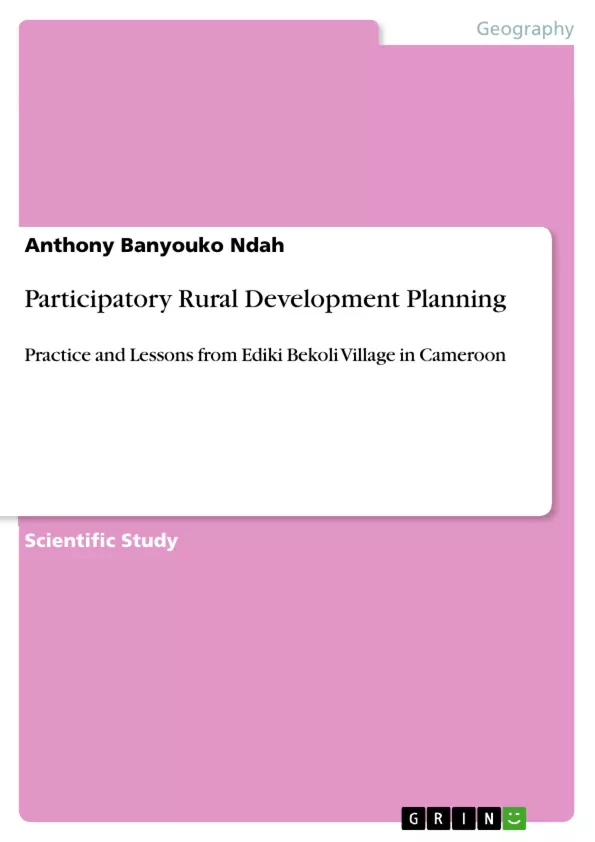This report presents the outcome of a ten-day mission carried out in 2009 with the goal to prepare a development plan for Ediki-Bekoli Village. The researchers conducted an ethnographic-type research with the aim being to guide and facilitate a community-led development planning process for the village from which this Village Development Plan (VDP) was born. Upon arrival in the village, the researchers were hosted by the village chief who convened a meeting with his councilors to discuss the purpose of the expedition, and from there, work kicked off. This VDP document was therefore prepared based on the approach to development planning which focuses on the principles of promoting sustainable livelihoods and self-reliant bottom-up development.
A manual including different participatory learning tools and methods prepared by the capacity building component of Rumpi Project was used throughout the step by step planning process as well as improvisations adapted from other community development experiences around the world. The specific objective is to assist the community better their livelihoods and find solutions that will increase the income of the small-holders within the village thereby contributing to poverty alleviation. Following the initial participatory village assessment (PRA) stage, conducted with the entire community, the following problems were uncovered and prioritized.
These problems include low agricultural productivity, lack of formal/informal technical training, poor road infrastructure, exposed water sources/ lack of potable water which engenders all kinds of health issues, and youth unemployment. Based on the above problems the following goals were formulated, followed by the elaboration of micro-projects based on these goals: to improve agricultural productivity; improve community health and well-being; to improve communication and rural infrastructure; to enhance rural capacity through the development of technical skills; institute community financing mechanisms These micro-projects, if implemented, will meet some of the developmental needs and aspirations of Ediki-Bekoli as perceived by the community itself, leading to the alleviation of poverty.
Inhaltsverzeichnis (Table of Contents)
- CHAPTER ONE. INTRODUCTION
- 1. BACKGROUND INFORMATION.
- 1.1 Location and accessibility.
- 1.2. Climate and Vegetation.......
- CHAPTER TWO. VILLAGE ORGANIZTION AND POPULATION STRUCTURE...
- 2. Organizational Structure .......
- 2.1. Village Institutions..
- 2.2. Population.....
- 2.3. Ethnic groups
- CHAPTER 3 PARTICIPATORY LAND USE AND COMMUNITY LIVELIHOOD ANALYSIS ....
- 3. LIVELIHOOD ACTIVITIES
- 3.1. Farming ….…………………..
- 3.2. Non-timber forest products (NTFPs).
- 3.3. Palm wine Tapping.
- 3.4. Hunting.
- 3.5. Trading......
- 3.6. Sources of income.
- 3.7. Land use systems
- 3.8. Land Tenure ........
- CHAPTER 4 SOCIO-DEVELOPMENTAL ISSUES IN EDIKI BEKOLI VILLAGE.......
- 4. Socio-developmental concerns of the community.
- 4.1. Soil quality concerns and land-use planning:
- 4.2. Local Market concerns:.
- 4.3. Potable water concerns:
- 4.4. Power supply:..
- 4.5. Poor road network....
- 4.6. Social concerns
- 4.7. Limited Social Amenities
- 4.8. Diseases and health care
- 4.9. Education
- 4.10. Limited retail outlets.
- 4.11. Limited agricultural productivity..
- 4.12. Limited employment opportunities.....
- 4.13. Problem tree analysis
- CHAPTER 5. PARTICIPATORY NEEDS ASSESSMENT AND COMMUNITY VISION
- 5. Participatory problem identification by Gender and Age groups.
- 5.1. Issues identification within socio-professional groups ..
- 5.2.Prioritized problems and proposed solutions.
- 5.3. Participatory Strategic Action needs and project development ......
- 5.4. Community Vision
Zielsetzung und Themenschwerpunkte (Objectives and Key Themes)
This report details the development of a plan for Ediki-Bekoli Village in Cameroon, achieved through participatory rural development planning methods. The research aimed to guide and facilitate community-led development for the village, leading to the creation of a Village Development Plan (VDP). This approach emphasizes sustainable livelihoods and bottom-up development, focusing on:
- People-centered solutions
- Participatory and responsive planning
- Needs-based development
- Leveraging local strengths
- Holistic community development
Zusammenfassung der Kapitel (Chapter Summaries)
- Chapter One: Introduction: This chapter provides background information on Ediki Bekoli Village, including its location, accessibility, climate, and vegetation. It sets the stage for the village's socio-economic context.
- Chapter Two: Village Organization and Population Structure: This chapter delves into the village's organizational structure, focusing on institutions and population characteristics. It analyzes the demographic makeup of the community, including its ethnic groups.
- Chapter Three: Participatory Land Use and Community Livelihood Analysis: This chapter examines the village's livelihood activities, including farming, non-timber forest products (NTFPs), palm wine tapping, hunting, trading, and income sources. It also explores land use systems and tenure.
- Chapter Four: Socio-Developmental Issues in Ediki Bekoli Village: This chapter identifies and analyzes various socio-developmental issues facing the community, such as soil quality concerns, market access, water scarcity, inadequate power supply, poor road infrastructure, social concerns, limited amenities, health issues, education, retail availability, agricultural productivity, and employment opportunities. It also includes a problem tree analysis to delve deeper into the interconnectedness of these challenges.
- Chapter Five: Participatory Needs Assessment and Community Vision: This chapter focuses on participatory problem identification within the community, exploring issues across gender and age groups. It outlines prioritized problems and proposed solutions, explores strategic action needs and project development, and culminates in the articulation of a shared community vision for the future.
Schlüsselwörter (Keywords)
Key terms and concepts that underpin this report include participatory rural development planning, community-led development, Village Development Plan (VDP), sustainable livelihoods, bottom-up development, participatory rural appraisal (PRA), socio-economic challenges, livelihood activities, land use, land tenure, community vision, and problem tree analysis.
- Quote paper
- Dr. Anthony Banyouko Ndah (Author), 2018, Participatory Rural Development Planning, Munich, GRIN Verlag, https://www.grin.com/document/441403



